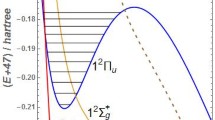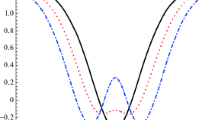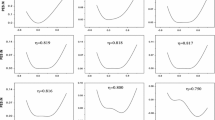Abstract
The inverse square potential is used to provide the ‘pictures’ of the transitions symmetry from U(5) to O(6) via the variational procedure of the E(5) solutions. The variation of the single-parameter \(\beta _{0}\) of the inverse square potential shifts the E(5) solutions: the energy eigenvalues increase when \(\beta _{0}\) increases. In the theoretical prediction of \(R_{L/2}\), \(\beta _{0}=0\) yields solutions that correspond to the U(5) symmetry of the Bohr Hamiltonian with \(R_{4/2}=2.00\). As \(\beta _{0}\) increases, the solutions of E(5) materialize with \(R_{4/2}=2.189\) at \(\beta _{0,max}=3.986\). The solutions leave E(5) and approach O(6) with \(R_{4/2}=2.466\) at \(\beta _{0}=25\). The solutions of \(^{132}Xe\) and \(^{134}Xe\) of the E(5) symmetry candidates are fitted and compared with the available experimental values. With the same variational method, the ratios of B(E2) transition rates within the ground state leave O(6) and approach E(5) solution as \(\beta _{0}\) increases.
Graphic abstract









Similar content being viewed by others
References
F. Iachello, Dynamic symmetries at the critical point. Phys. Rev. Lett. 85(17), 3580 (2000)
F. Iachello, Analytic description of critical point nuclei in a spherical-axially deformed shape phase transition. Phys. Rev. Lett. 87(5), 052502 (2001)
V.N. Zamfir, R.F. Casten, Phase/shape transitions in nuclear. Proc. Romanian Acad. Ser. A 4, 1–9 (2003)
R.F. Casten, Nuclear Structure from a Simple Perspective (Oxford University Press, Oxford, 1990)
R.F. Casten, N.V. Zamfir, Evidence for a possible \(E(5)\) symmetry in Ba-134. Phys. Rev. Lett. 85, 3584–3587 (2000)
J.M. Arias, \(E(2)\) Transitions and quadrupole moments in the \(E(5)\) symmetry. Phys. Rev. C 63, 034308 (2001)
R.M. Clark, M. Cromaz, M.A. Deleplanque, M. Descovich, R.M. Diamond, P. Fallon, I.Y. Lee, A.O. Macchiavelli, H. Mahmud, E. Rodriguez-Vieitez, F.S. Stephens, D. Ward, Searching for \(E(5)\) Behavior in Nuclei. Phys. Rev. C 69, 064322 (2004)
R. Fossion, D. Bonatsos, G.A. Lalazissis, \(E(5)\), \(X(5)\) and prolate to oblate shape phase transitions in relativistic Hartree–Bogoliubov theory. Phys. Rev. C 73, 044310 (2006)
R. Rodríguez-Guzmán, P. Sarriguren, \(E(5)\) and \(X(5)\) shape phase transitions within a Skyrme–Hartree–Fock \(+\) BCS approach. Phys. Rev. C 76, 064303 (2007)
M.W. Kirson, Comment on searching for \(E(5)\) behavior in nuclei. Phys. Rev. C 70, 049801 (2004)
Z.P. Li, T. Niksic, D. Vretenar, J. Meng, G.A. Lalazissis, P. Ring, Microscopic analysis of nuclear quantum phase transitions in the N \( \approx 90\) region. Phys. Rev. C 79, 054301 (2009)
T. Naz, G.H. Bhat, S. Jehangir, S. Ahmad, J.A. Sheikh, Microscopic description of structural evolution in Pd, Xe, Ba, Nd, Sm, Gd and Dy Isotopes. Nucl. Phys. A 979, 1–20 (2018)
V.N. Zamfir, M.A. Caprio, R.F. Casten, C.J. Barton, C.W. Beausang, Z. Berant, D.S. Brenner, W.T. Chou, J.R. Cooper, A.A. Hecht, R. Krücken, H. Newman, J.R. Novak, N. Pietralla, A. Wolf, K.E. Zyromski, \(^{102}Pd\): An \(E(5)\) Nucleus? Phys. Rev. C 65, 044325 (2002)
P. Baras, J.A. Golstein, Remarks on the Inverse Square Potential. North-Holland Math. Stud. 31–35 (1984)
D. Bouaziz, T. Birkandan, Singular inverse square potential in coordinate space with a minimal length. Ann. Phys. 387, 62–74 (2017)
A.M. Essin, D.J. Griffiths, Quantum mechanics of the \(\dfrac{1}{x^{2}}\) potential. Am. J. Phys. 74(2), 109 (2006)
R.P. Martínez-y-Romero, H.N. Núñez-Yépez, A.L. Salas-Brito, The Two Dimensional Motion of a Particle in an Inverse Square Potential: Classical and Quantum Aspects. J. Math. Phys. 54(5), 053509 (2013)
V.M. Vasyuta, V.M. Tkachuk, Falling of a quantum particle in an inverse square attractive potential. Eur. Phys. J. D 70, 267 (2016)
A. Bohr, B. Mottelson, Kgl. Danske Videnskab Selskab Mat. Fys. Medd. 27(16) (1953)
A. Bohr, Kgl. Danske Videnskab Selskab Mat.-Fys. Medd. 26(14) (1953)
A. Bohr, B.R. Mottelson, Nuclear Structure and Nuclear Deformations, vol. 748 (W. A. Benjamin Inc, Reading, Massachusetts, 1975), pp. 37–50
B. Podolsky, Quantum mechanically correct form of Hamiltonian function for conservative systems. Phys. Rev. 32, 812 (1928)
A. Bohr, Mat. Fys. Medd. K. Dan. Vidensk. Selsk. 26(14) (1952)
D. Bonatsos, D. Lenis, N. Minkov, P.P. Raychev, P.A. Terziev, Sequence of potentials interpolating between the \(U(5)\) and \(E(5)\) symmetries. Phys. Rev. C 69, 044316 (2003a)
D. Bonatsos, P.E. Georgoudis, D. Lennis, N. Minkov, C. Quesne, Fixing the moment of inertial in the Bohr Hamiltonian through supersymmetric quantum mechanics. Phys. Lett. A 683(3), 264–269 (2010)
L. Fortunato, Exact solutions of the Bohr Hamiltonian and symmetries of the collective model. Nuclear Theory 24, 280–294 (2005)
L. Wilets, M. Jean, Surface oscillations in even–even nuclei. Phys. Rev. 102, 3 (1956)
D.R. Bés, The \(\gamma \)-dependent part of the wave functions representing \(\gamma \)-unstable surface vibration. Phys. Lett. B 10(1), 1–708 (1959)
F. Iachello, A. Arima, The Interacting Boson Model (Cambridge University Press, Cambridge, 1987)
I.S. Gradshteyn, I.M. Ryzhik, Table of Integral Series and Products (Academic, New York, 1980)
M. Abramowitz, I.A. Stegun, Handbook of Mathematical Functions (Dover, New York, 1965)
M. Alimohammadi, H. Hassanabadi, \(\gamma \)-Rigid regime of the Bohr-Mottelson Hamiltonian in energy-dependent approach. Int. J. Mod. Phys. E 25(1650087), 9–11 (2016)
M. Alimohammadi, H. Hassanabadi, Alternative solution of the \(\gamma \)-rigid Bohr Hamiltonian in minimal length formalism. Nucl. Phys. A 957, 439–449 (2016)
D. Bonatsos, D. Lenis, N. Minkov, P.P. Raychev, P.A. Terziev, Ground State Bands of the \(E(5)\) and \(X(5)\) Critical Symmetries Obtained from Davidson Potentials through a Variational Procedure. Physics Letter B 584, 1–2 (2003b)
R. Budaca, Bohr Hamiltonian with an energy dependent \(\gamma \)-unstable coulomb-like potential. Eur. Phys. J. A 52, 314 (2017)
C. Hutter, R. Krücken, A. Aprahamian, C.J. Barton, C.W. Beausang, M.A. Caprio, R.F. Casten, W.T. Chou, R.M. Clark, D. Cline, J.R. Cooper, M. Cromaz, A.A. Hecht, A.O. Macchiavelli, N. Pietralla, M. Shawcross, M.A. Stoyer, C.Y. Wu, N.V. Zamfir, \(B(E2)\) Values and the search for the critical point symmetry \(X(5)\) in \(^{104}Mo\) and \(^{106}Mo\). Phys. Rev. C 67, 054315 (2003)
I. Inci, D. Bonatsos, I. Boztosun, Electric Quadrupole Transitions of the Bohr Hamiltonian with the Morse Potential. Phys. Rev. C 84, 024309 (2011)
B. Singh, Nucl. Data Sheets 93(1), 1–242 (2001)
Yu. Khazov, A.A. Rodionov, S. Sakharov, B. Singh, Nuclear Data Sheets 104, 497 (2005)
L. Fortunato, Solutions of the Bohr Hamiltonian, a Compendium. Eur. Phys. J. A 26, 1–30 (2004)
U. Kneissl, Key Topics in Nuclear Structures, Covello, A. (Ed.) (Paestum, World Scientific, Singapore, 2004), p. 399
Author information
Authors and Affiliations
Corresponding author
Appendix A: Mathematical procedure for calculating B(E2) transition probabilities
Appendix A: Mathematical procedure for calculating B(E2) transition probabilities
The B(E2) transition rates are given as
where L is the angular momentum, \(\varrho \) is another quantum number different from L, i denotes initial state, f denotes final state and \(T^{E2}\) is the quadrupole operator which has been defined as [29]
\(\theta _{i}\), \(\gamma \) and \(\beta \) have been defined in the manuscript. t is a scale factor and \(D(\theta _{i})\) represent the Wigner functions of the Euler angle. By following the procedures listed in [29],
and
\(R_{n_{\beta },\tau }(\beta )\) are the wavefunctions which have been obtained, \(n_{\beta }^{\prime }=s^{\prime }-1\) as \(n_{\beta } = s-1\) which involve Bessel functions of the wavefunctions. All transitions are normalized to \(B(E2 : 2_{0,1}\longrightarrow 0_{0,1} ) = 100\). The lowest B(E2) ratios within the gsb band is
Rights and permissions
About this article
Cite this article
Ajulo, K.R., Oyewumi, K.J., Oyun, O.S. et al. U(5) and O(6) shape phase transitions via E(5) inverse square potential solutions. Eur. Phys. J. Plus 136, 500 (2021). https://doi.org/10.1140/epjp/s13360-021-01451-7
Received:
Accepted:
Published:
DOI: https://doi.org/10.1140/epjp/s13360-021-01451-7




